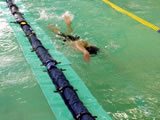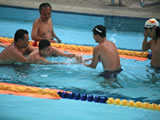Industry-Government-Academia Collaboration - A Case Study
Development of a "Course Guide" for the Visually Impaired Swimmers
by Associate Professor Yuji Ohgi of the Graduate School of Media and Governance
This page offers a case study of various research activities and the results of industry-government-academia collaboration conducted at the Keio SFC Research Institute. (Position titles are those at the time of release.)
>> Archive of Industry-Government-Academia Collaboration - A Case Study
Development of a "Course Guide" for the Visually Impaired Swimmers
by Associate Professor Yuji Ohgi of the Graduate School of Media and Governance
Associate Professor Yuji Ohgi of the Graduate School of Media and Governance has developed a "Course Guide" for the visually impaired swimmers and succeeded in commercializing it after applying for a patent for it. We asked him to share with us the process and progress associated with its technological development.
 Course Guide: An evaluating experiment on a prototype Q. Could you briefly introduce us to the "Course Guide" which has just been commercialized?
Associate Professor Ohgi: It's an equipment to support the visually impaired people to swim in a pool "safely" and "in a straight path". A "Course Guide" is a band made from a sweat-suit fabric which is put around the lane line dividing the courses. Visually impaired people use the band to guide them as they swim in the pool. The band is built keeping in mind the safety of the swimmers. As the swimmers thrust their hand against the soft band while swimming, their hand will automatically slide along the band back into the water. In addition, a person will be able to swim in a straight path by touching the band or sliding his/her side against it. Before we invented the band rope it was rather difficult for visually impaired beginners to swim in a straight line.
Q. Could you tell us about the trigger that started the development and commercialization of the "Course Guide"?
Associate Professor Ohgi: My area of research is Sports Engineering and I myself have been involved in swimming for years. The research conference of the Japanese Society of Sciences in Swimming and Water Exercise was convened in Kobe in 2004. Incidentally I am a member of its advisory board. Every year during the conference, we conduct a practical training in the pool to encourage exchanges with those involved in coaching. The theme for 2004 was "Coaching of Visually Impaired Swimmers" and a Paralympic gold medalist Junichi Kawai (a worldwide swimmer who has obtained five gold medals in the four Paralympics in the past) conducted a seminar on coaching techniques. After the program, the fingers on his right were found to be bleeding. He laughed and said, "Since I cannot see, I always hit the lane line. It happens all the time. Some people even jam their fingers." I was shocked by his words and felt deeply in my heart that something must be done. For the next few months, I began to look for a solution in my own way. I talked to my acquaintance, Mr. Seiji Hattori, the C.E.O. of Apollo £”ports £√o. Ltd. (a company that develops and designs diving equipment), and asked him to develop a prototype fabric to be put around lane lines. After the prototype was ready, I visited camps for the visually impaired swimmers, sought the help of the swimming club of the School for the Visually Impaired°§University of Tsukuba, and conducted a one-year evaluation experiment in order to make further refinement to the material and design. Marisa Hamamoto, an undergraduate student of my laboratory, helped in conducting the experiment. You might be aware that there are several stages of visual disability-- there are visually impaired people who have weak eyesight and those who are completely blind. So we gave extra consideration to the color and length of the fabric so that visually impaired swimmers could feel that they were approaching the wall of the swimming pool. After we brushed up our ideas and completed making improvements to the prototype, we applied for a patent through the Keio University Intellectual Property Center. The Pool Division of Yamaha Motor Company Ltd., acknowledged the value of the product, and has listed it in its catalog as a pool equipment. It is now for sale.
 JICA Program in Malaysia in summer 2006 Q. Has the "Course Guide" been used in some places?
Associate Professor Ohgi: Yes. This summer, the JICA conducted a sports-coaching program for the visually impaired in Malaysia, and trainers including Mr. Kawai and Mr. Masato Teranishi, teacher of the School for the Visually Impaired, University of Tsukuba, used the "Course Guide" to coach local visually impaired swimmers, especially beginners. I hope that the "Course Guide" is also used in places such as public pools, pools in blind schools, and sports centers for the physically challenged so that visually impaired persons can enjoy swimming in a safe environment. While it is often said that the visually impaired persons are short of exercise, athletic sports such as running and ball games are not safe as the player gets hit with a ball or with other players. In this sense, swimming is quite safe and good for resolving the lack of exercise as it requires full body movement. I hope that the "Course Guide" will serve to make those who enjoy swimming do their training feeling secure and to increase swimming population if only a little.
Q. Are you going to continue developing sports products for physically challenged in future?
Associate Professor Ohgi: Yes, I want to focus specifically on developing equipments that make sports activities safer and more enjoyable for the physically challenged.
(Release Date: 2006/9/21)
|

